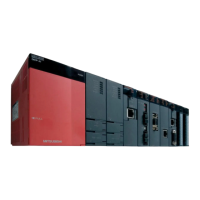10
FUNCTIONS AND PROGRAMMING
10.3 Programming Using MELSEC Data Link Functions
10.3.4 Programming using MELSEC data link functions
10 - 38
9
UTILITY OPERATION
10
FUNCTIONS AND
PROGRAMMING
11
OVERVIEW OF
MULTIPLE CPU
SYSTEM
12
MULTIPLE CPU
SYSTEM
CONFIGURATION
13
MULTIPLE CPU
SYSTEM
CONCEPT
14
COMMUNICATIONS
BETWEEN CPU
MODULES
15
PARAMETERS
ADDED FOR
MULTIPLE CPU
16
PRECAUTIONS FOR
USE OF AnS SERIES
MODULE
(2) Precautions for using MELSEC data link functions
(a) Precautions for programming
1) Opening/closing communication lines
Open and close a communication line (mdOpen and mdClose functions) only
once at the start (task start) and end (task end) of each user program task.
Communication performance will be affected if open/close is repeated at each
communication.
2) Execution time at initial execution
If a device is added in the function, it will collect the programmable controller
information in detail during initial execution.
Since this increases the initial function execution time, make dummy access to
each target in advance.
3) MELSEC data link function execution in multiple tasks
The MELSEC communication functions cannot be processed concurrently in
multiple tasks inside the C Controller module.
If this is requested, a MELSEC data link function processing requested by a
task have to wait until another MELSEC data link function processing
requested by another task is completed.
Hence, make a program with care so that the main processing ( This
section (1) 4), 5)) is executed after the preparatory processing ( This
section (1) 3))is completed in all tasks.
4) Access to other stations from the same task
Communication performance may be affected if access to 9 or more other
stations is made concurrently from the same task of the C Controller module
using a user program.
The number of other stations concurrently accessed from the C Controller
module must be limited within 8 stations in the same task.
5) Other station access
When access to another station is made from the C Controller module via a
bus interface, CC-Link module, or MELSECNET/H module, one
communication processing has to wait until another processing is completed.
Therefore, if one communication processing times out, the other
communication processings may also time out.

